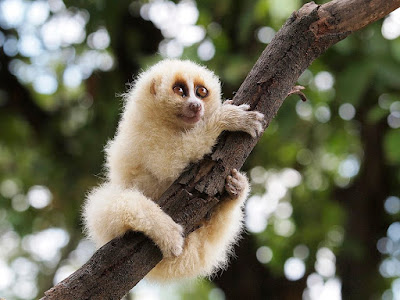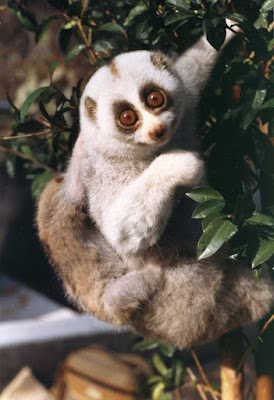Slow Loris: Unveiling the Mysterious World of Nocturnal Primates
In the dimly lit areas of Southeast Asian forests, a creature of awe-inspiring charm and mystical allure emerges as a symbol of nocturnal wonder – the slow loris. With their captivating gaze, well-thought-out movements and interesting behaviours, slow loris provide an opportunity to explore the nuances of a species adapted to the rhythm of the night. Join us on a journey into the captivating world of the slow loris, uncovering its unique characteristics, behaviors, and the challenges it faces in a rapidly changing world.
A Closer Look at the Slow Loris
The slow loris (genus Nycticebus) is a small to medium-sized primate that lives in the tropical forests of Southeast Asia, including areas of Thailand, Indonesia, Malaysia, and the Philippines. The name "slow loris" is a testament to its leisurely, deliberate pace—a characteristic that sets it apart from the frantic activities associated with the animal kingdom.
The slow loris is immediately recognizable by its large, round eyes that glow like twin beacons in the night. These large eyes contribute to its exceptional night vision, allowing it to navigate the dark corners of its forest home with astonishing precision. A reflective layer called the tapetum lucidum further enhances its ability to see in low light conditions, a feature essential to its nocturnal lifestyle.
Poisonous truth
Perhaps one of the most interesting aspects of the slow loris is its venomous bite, a trait that challenges conventional wisdom about primates. Some species of slow loris have a special gland in their elbow that produces venom. When mixed with their saliva, this venom becomes a formidable defense mechanism. Slow loris deliver a venomous bite when threatened or provoked, and the effects can be extremely painful and, in extreme cases, fatal to humans.
This unique adaptation underlies the slow loris' remarkable journey through evolution, illustrating the myriad ways in which species adapt to their environment to ensure their survival. The venomous bite serves as a powerful reminder of the complexity of nature and the astonishing diversity of strategies that creatures employ to protect themselves.
Stasis and camouflage
Slow loris are known not only for their venomous bite, but also for their mesmerizing behavior, known as "stasis". When the slow lory senses danger, it raises its arms and freezes in place, often rocking slowly from side to side. This behavior, combined with its cryptic coloration, allows it to blend seamlessly into its surroundings, effectively avoid predators, and remain unknown.
The slow loris' tendency to slow, deliberate movements extends beyond pauses. Its laid-back approach to life helps conserve energy, an essential feature in a world where resources can be scarce. This energy-efficient lifestyle enables slow lorises to thrive in their habitat and adapt to challenges posed by their environment.
Conservation Challenges and Efforts
Unfortunately, the slow loris faces a variety of conservation challenges that threaten its survival. Habitat loss due to deforestation, illegal pet trade and hunting for traditional medicine are some of the primary threats facing these creatures. The slow loris' adorable appearance has also contributed to its exploitation as an exotic pet, despite the fact that they are not suitable for captivity and require specific care.
Conservationists and researchers are working diligently to protect the slow loris and its habitat. Educational campaigns aimed at raising awareness of the dangers of the illegal pet trade and advocating for the conservation of forests are important steps in ensuring the survival of these mesmerizing primates.
The slow loris is a testament to the richness of our planet's biodiversity and the complex ways in which species have adapted to their environments. Its captivating gaze, deliberate movements and intriguing behavior offer a glimpse of the complexity of the natural world. As we strive to protect these mysterious creatures from the threats they face, we must also recognize the vital role they play in maintaining the delicate balance of their ecosystems. The story of the slow loris serves as a reminder that every species, no matter how small, contributes to the framework of life on Earth.
Here are some interesting facts about the Slow Loris:
- Nocturnal Adaptations: The slow loris is a nocturnal animal, meaning it is most active during the night. Its large round eyes are adapted for excellent night vision, allowing it to navigate even in low light conditions.
- Deliberate Movements: True to their name, slow loris are known for their deliberate and slow movements. Its fast speed helps it save energy and makes it adept at staying hidden in the forest.
- Venomous Bite: Some species of slow loris have a venomous bite. They have special glands in their elbows that produce poison. When mixed with saliva and delivered through bites, the venom can cause pain, swelling, and even death in some cases.
- Stasis Behavior: When threatened, slow lorises display a unique behavior known as "stasis". It raises its arms and stands still, occasionally swaying gently. This behavior, combined with its camouflage, helps it avoid being detected by predators.
- Camouflaged Coat: Slow loris have a dense and woolly coat that comes in various shades of brown, gray and even red. This camouflage helps it to blend in with its forest environment.
- Grooming Routine: Slow Lorries have a specific grooming routine. They have a toothcomb, produced by specialized lower incisors, and a specialized claw, which they use to carefully groom their hair.
- Solitary Lifestyle: Slow lorises are generally solitary animals, with each individual having its own territory. They communicate with each other through vocalizations and scent marking.
- Nocturnal Diet: Their diet mainly consists of insects like ants, termites and beetles. They feed on tree sap, sap, fruits and sometimes even small vertebrates.
- Maternal Care: Female slow loris carry their young on their stomachs or backs for several weeks after birth. When the mother passes through the trees, the babies cling to her, providing her with protection and warmth.
- Conservation Concerns: Slow loris face significant threats due to habitat loss due to deforestation, the illegal pet trade, and hunting. Despite their unsuitability for captivity, their attractive appearance has led them to be caught and sold as exotic pets.
- Species diversity: There are several species of slow loris, including the Sunda slow loris, the Bengal slow loris, and the Javan slow loris, each with distinct characteristics and distributions.
- Unique hands: The slow loris has a special hand structure that allows it to have a strong grip on branches. Its thumb is short and contains a small flattened nail, which helps it to grasp and manipulate objects.
- Specialized Diet and Adaptations: Slow loris' digestive systems have adaptations to handle a diet rich in gums and nectar. Its specialized teeth and digestive processes help extract nutrients from its varied diet.




Comments
Post a Comment